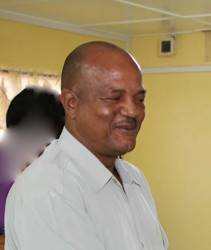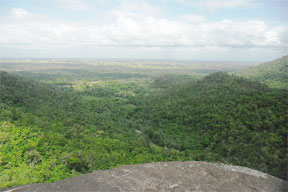Region Nine is bracing itself for food shortages as the persistent dry weather is depleting what is left of the region’s usable water sources, according to Region Nine’s Regional Executive Officer (REO) Carl Parker.
Parker told Stabroek News via telephone that the situation has left residents struggling to locate useable water sources as the current conditions, which are as a result of the El Nino weather phenomenon, are expected to last until the end of June.
Parker said the availability of water in the region is a “very serious issue to deal with right now,” before going on to explain that even if the rains were to return to the Rupununi, the region stands a chance of facing a food crisis.

“As it is, we are anticipating food shortages, since crops are failing as a direct result of the lack of readily available water supplies,” he said.
Animals are also feeling the heat of the situation; with not enough flowing water in the rivers, the fish population in the area would not have been able to swim up river to spawn.
And although he has not received much reports of domesticated animals having died as a consequence of the water shortage, Parker reflected on a report he had received in December concerning the deaths of several cows. Based on the report, a total of 15 cows had allegedly dropped dead in the savannahs of South Central Rupununi. The deaths of the animals were later linked to the effects of weather conditions.
Parker added that although he has not received any additional reports of such a nature, he is almost certain that such cases are occurring.

Failing wells and Savannah fires were also mentioned by the REO, who revealed that based on daily reports submitted to his office, approximately 85% of the hand dug wells in the different districts have already dried up, while 50% of those facilitated by the Guyana Water Incorporated have also failed. As a result, the GWI wells are unable to properly supply residents and government facilities in the district.
Further, Stabroek News was told that residents have taken it upon themselves to drill their own wells, which Parker explained happens to be illegal, since such practices are said to affect the aquifer levels. Parker stated that such activity had been happening before May last year and as it is the aquifers have dropped an additional 36ft from where they were before. He went on to explain that an administrative decision was made to approach those guilty of such acts and tap into those illegal wells with the intention of creating a network for the flow of water.
If, however, these residents refuse to comply, the GWI has been directed to seal the wells, since they are hindering other residents’ access to water.
Parker went on to say that those who reside near rivers are better off, however, as the current weather condition stretches on sources of water are becoming even scarcer. The Kumu Falls, located a few hours away from Lethem, have stopped running, while two ponds in Shulinab Village have gone dry. According to the REO, he has never known the ponds in that village to ever be without water. Several creeks in the Rupununi have also reportedly dried up.
Savannah fires
And with no sign of rain for the Rupununi, savannah fires have become a frequent occurrence in the region.
“Savannah fires have become a frequent issue as almost nightly the fire tender has to be summoned to extinguish grass fires,” Parker lamented. He noted one instance two Saturdays ago where he found himself going to assist the volunteer fire fighters to extinguish a fire that an “uncaring person” had lit a fire short distance away from a gas station in Lethem. Thankfully, they were able to put it out before it reached the gas station.
As a result, Parker is urging residents to desist from lighting fires in the savannahs as the “stiff, dry” winds act as an accelerant for the fires to spread. This, he said, coupled with the fact that the only fire tender at their disposal has a water capacity of 450 gallons, can prove to be disastrous.
Meanwhile, Parker explained that the situation is being addressed with a multi-sectoral approach. He pointed out that the situation is currently being monitored at an administrative level as the Regional Disaster Risk Reduction Unit has been actively engaged in discussions with officials from the health, education sectors and GWI to determine what other support mechanisms can be implemented to assist with the drought.
Additionally, Parker disclosed plans to seek approval to purchase five solar-powered submersible water pumps and have them distributed for immediate use in the sub-districts.
He explained that based on research done, these portable pumps are designed to filter brackish water into water that can be utilised by residents for domestic consumption. But in order for efficient use, they would have to be set up in areas where there are still large bodies of water.
Minister of Indigenous Peoples Affairs Sydney Allicock also told Stabroek News that his ministry is working tirelessly with the Civil Defence Commission (CDC) to establish other ways to offer support to the region. However, he noted that more planning and equipment are needed to fight the effects of the drought.
Two weeks ago, government announced that with the forecast prolonged dry season, Cabinet had taken a decision to have the situation strictly monitored and recommendations analysed so as to tackle the issue. This will include amped up conservation sensitisation exercises countrywide.
“Cabinet was also briefed about the persistent dry conditions across Guyana. These conditions, are part of … El Nino weather conditions affecting not only Guyana but the entire Caribbean. Nationally, Regions 2, 3, 4, 5, 6 and 9 and 10 are facing severe shortage of water. On the coastlands, the rice and sugar crops are affected and the projection is that if there is no rain coming in a short period of time the situation can get worse,” Minister of State Joseph Harmon told reporters at a post-Cabinet press briefing.







